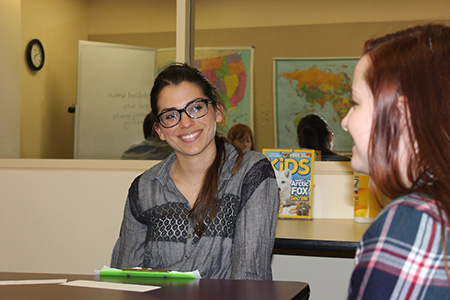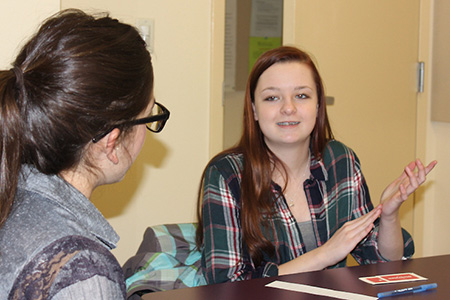Stuttering therapy focus of new fluency program
Fluency in speech is something most of us don’t have to think about. But for people who stutter, speech fluency is a major goal.
At the Robbins Speech, Language, and Hearing Center at Emerson College, in the Communication Sciences and Disorders Department, graduate students are helping clients who stutter achieve that goal through the new Fluency Disorders Concentration Program, under the Program for Speech Improvement.
Adriana DiGrande, a licensed speech language pathologist and the clinical supervisor, says this program is unique.
“Our graduate students will have the opportunity to gain a broad range of experiences in working with people who stutter,” DiGrande said. “Our students see the client through the entire continuum of care. Our students are involved in the first diagnostic session, and they’ll follow that client through individual therapy.”

Speech therapy graduate student Lindsey Wilk, MS ’15, conducts therapy with 15-year-old Triona Murray, who is overcoming stuttering issues. (Photo by Elliot Friar ’16)
Bridget MacLeod, MS ’15, has worked with clients for about a year. She said the hands-on clinical experience is invaluable.
“Prior to doing the program in fluency here, I really didn’t even know where to start with a client, whether it be with a child or an adult,” MacLeod said. “I really didn’t even know how to evaluate someone with stuttering. But now that I’ve gone through the program, I feel pretty confident in evaluating a toddler all the way to an adult.”
While clinical treatment of stuttering is important, MacLeod says treating the social and emotional effects of stuttering is even more important.
“It’s not just what you see and what you hear,” she said. “There’s a lot of emotion and feelings involved with stuttering. And kind of homing in on that and working with their feelings is the more important piece.”
One way the fluency program approaches these issues is through creative expression. In one activity, clients are asked to draw how they feel in regard to their stuttering, and what fluency means to them.

In The Robbins Center’s new Fluency Disorders Concentration Program, clients are encouraged to draw their feelings in relation to their stuttering.
Triona Murray, a 15-year-old client from Braintree, drew fluency as a smashed wall, with the words going directly to the person.
“Before the program, I would not participate in class,” Murray said. “I would just avoid talking to strangers and avoid taking to people I didn’t really feel comfortable with.”

Triona Murray, age 15, receives therapy at the Robbins Center’s Fluency Disorders Concentration Program at Emerson. (Photo by Elliot Friar ’16)
But after working with the graduate students and doing real-life exercises of social engagement with strangers—which included simple tasks, such as calling a restaurant and asking for its hours of operation—Murray noticed a difference.
“I could see the progress,” she said. “At first I would stutter a lot, and towards the end I would barely stutter. I was fluent.”
Murray, who now speaks largely without difficulty, said she has a message for the world about stuttering.
“I’ve had people who have no idea what stuttering is, and they would look at me like I had eight heads,” she said. “I’ve actually had a friend… she said when she first heard me stutter she thought I had special needs or something… If I could say one thing to the world, it would be people who stutter are normal people, they just have trouble talking.”
Categories